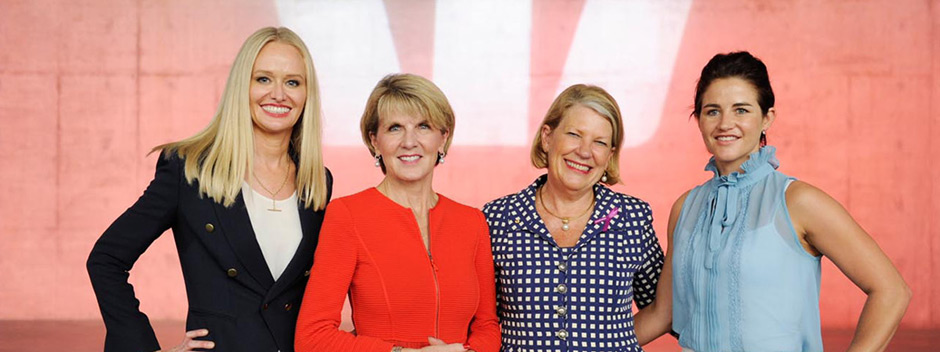Westpac has seen the number of women in senior ranks rise steadily over the past six years. In 2010, women made up 33% of the leadership team. By late last year, it was 46% with a target of 50% by 2017. But those targets will “wither on the vine” without supporting programs, says Westpac’s Ainslie van Onselen, Director of Women's Markets, Inclusion and Diversity (pictured far left).
“What’s underpinned our headline target is a number of initiatives that include what we call ‘hard wiring’ and ‘soft wiring’,” says van Onselen.
Hard wiring sees the target included in key performance indicators and scoreboards all senior leaders, including group executives and the CEO.
“That’s a major point of difference as far as helping to ensure a really laser-like focus on it,” says van Onselen.
“Then we have a number of sub-mandates, such as ensuring that 50% of our graduates are women, so we have a really strong pipeline, and ensuring that more than half of those on our high potential programs are women. Those programs are really key because you really can’t have a promotion at Westpac without having been identified as high potential talent, and having gone through various leadership programs.”
There’s a requirement for shortlists to be 50% female, which is seen as a crucial step in getting the hiring conversion rate to 50% or above (it’s now 54%).
Soft wiring initiatives include leadership programs for women only “because our research has shown they have specific needs and wants”, mentoring and recognition programs. Meanwhile, the popular employee action group Women of Westpac provides activities such as TEDx talks and professional development seminars for its 2,700 members.
Working on unconscious bias
Unconscious bias training, which began in 2013, provided the “a-ha moment” in Westpac’s approach to diversity and inclusion but further work was needed, says van Onselen.
While creating awareness of unconscious bias is good, the next step is to work on how behaviour can change.
Westpac gave managers practical tools and tips to help them nurture behavioural change in themselves and their reports and asked them to write up action plans after the program. “So there’s a lot of follow-up”, says van Onselen.
The organisation has also signed up to the Victorian Government’s Recruit Smarter campaign that aims to reduce unconscious bias. During an 18-month pilot, the government is working with a number of public and private sector organisations to change recruitment processes by removing personal details such as name, age and gender from job applications – so-called ‘blind CVs’.
Westpac’s pilot is testing blind CVs in business units where women are underrepresented. After a shortlist is compiled, its composition will be compared to the organisation’s usual shortlist makeup.
“In addition, we’ll be reviewing the roles and how they’re advertised. It’s important to keep emphasising flexibility and other related programs we have in place,” says van Onselen.
Making it to the shortlist
While the CVs are unmasked at the shortlist stage, van Onselen isn’t concerned that women could be discriminated during interviews.
“That’s where we’re ahead of the curve. Because of the programs we’ve been implementing for six years, we’re really good at hiring women who’ve made a shortlist,” she says.
“They’ve actually got better odds than a guy on our business average; we hire more women from shortlists than we do men. So that’s not a problem we need to address.
“That’s why I’m specifically interested in masking CVs, because that’s where I think we can get the biggest improvement.”
Westpac’s CV masking pilot will also remove cultural markers in line with its cultural diversity program.
An Australian study, now more than six years old but with startling findings still referred to today, found that job applicants with Anglo-Saxon names were more likely to be called in for an interview.
Australian National University economists Professor Alison Booth and Professor Andrew Leigh (now a federal MP) and researcher Elena Varganova sent out 4,000 fake CVs in response to job ads. Using different names representing various cultural groups they discovered that Indigenous applicants needed to put in 35% more job applications to get the same number of call backs as someone with an Anglo-Saxon name. A Chinese applicant needed to put in 68% more, a Middle Eastern applicant 64% more and an Italian applicant 12% more than an Anglo-Saxon job applicant.
When it came to gender, Chinese men were more likely to be called in for an interview than Chinese women, but Italian women were more likely than Italian men to be successful.
For Westpac, the study underlines the potential value of masking CVs. “We know that having targets – what gets measured – matters and I’m curious to see if what gets masked matters as well for us because the findings of the ANU report were remarkable,” van Onselen says.

